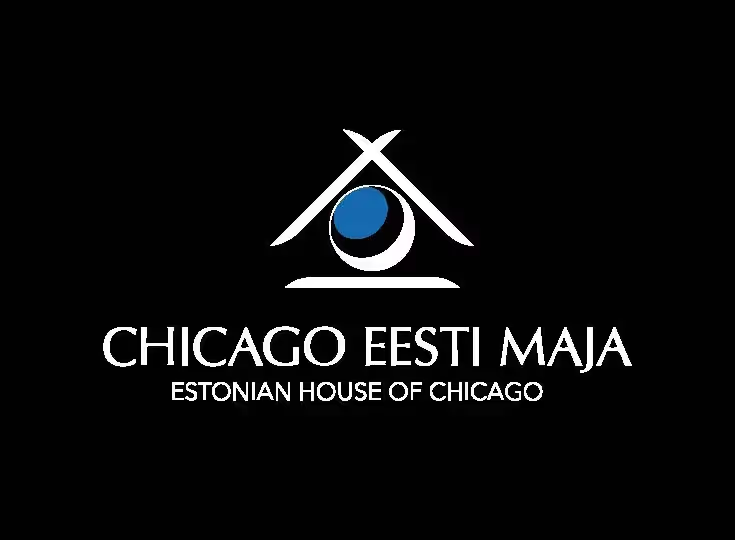His work on both coasts ensures these communities project a professional and culturally resonant image—one that honors their heritage while appealing to newer generations.
Culturally Driven Design
Born in Estonia and educated in the arts—he attended the Tallinn Art School—Molder channels his cultural background into every project. Whether designing event posters, publications, or merchandise, he integrates Estonian motifs and symbols to reflect and celebrate heritage. Community members have noted that his volunteer-driven projects not only look modern but also speak to the deep traditions that keep diasporic communities connected to their roots.

The NEW YORK ESTONIAN HOUSE Logo: A Fresh Take on Tradition
A Historic Institution
Founded on December 7, 1929, the NEW YORK ESTONIAN HOUSE—officially the New York Estonian Educational Society (NYEES)—stands as one of the oldest Estonian diaspora institutions in the United States. After WWII, the Society purchased a four-story Beaux-Arts townhouse at 243 East 34th Street in Manhattan for $25,000, converting it into a permanent home that has fostered Estonian language, culture, and community ever since.

A Modern Redesign
When the NEW YORK ESTONIAN HOUSE decided it needed a more contemporary visual identity, Molder introduced a logo centered on the barn swallow, Estonia’s national bird. The silhouette incorporates Estonia’s signature blue, black, and white tricolor, which the official brand guidelines also define as its core palette. This approach creates a polished yet culturally meaningful look—essential for representing an Estonian institution in one of the world’s most cosmopolitan cities.
For those who left Estonia or are generations removed, the barn swallow’s migratory symbolism reflects the experience of seeking new horizons while retaining a connection to the homeland. As one House member notes, “It reminds us of how we carry our cultural identity wherever we go. The swallow may fly across oceans, but it never forgets its roots.”
Board members see the redesigned logo as part of a wider effort to rejuvenate the House’s presence in the post-pandemic era—updating the website, enhancing social media engagement, and re-energizing community members. The updated look, officially spelled out in the NEW YORK ESTONIAN HOUSE brand guide, ensures that this nearly century-old institution remains both recognizable and inviting for Estonians and friends of Estonian culture alike.








The CHICAGO ESTONIAN HOUSE: Bringing Heritage to the Heartland
A Key Midwestern Hub
Located in Riverwoods, Illinois, the CHICAGO ESTONIAN HOUSE has been a major cultural center since 1964. Like its New York counterpart, it is a focal point for Estonian gatherings—Independence Day celebrations, folk dance rehearsals, language classes, and beyond. By the early 2000s, however, leadership recognized that its visual identity needed an overhaul.

A Distinct Look Created in 2005
According to the designer himself, Alo N. Molder created the CHICAGO ESTONIAN HOUSE logo in 2005, during a period when Jaan Teetsov served as its manager. Around that same time, Molder was working with Mehis Vahtra—who would eventually succeed Teetsov—at Expand International and Country Connection. While the NEW YORK ESTONIAN HOUSE uses the barn swallow as a central emblem, Molder’s Chicago design employs clean lines and the Estonian tricolor in a more abstract presentation. This emphasizes unity with Estonian heritage yet maintains a unique identity distinct from the New York logo.
In creating the logo for the Chicago Estonian House, the inspiration came from the idea of bringing Estonians from every corner of the globe together under one roof. The design conveys a sense of belonging for anyone with Estonian roots, no matter how far they’ve traveled or how many generations have passed since leaving their homeland. By using strong visual elements that reference Estonia’s heritage, the logo symbolizes a welcoming home where community members can celebrate their shared culture and traditions.
Thanks to Molder’s thoughtful approach—tying traditional colors to modern typography—the House gained a crisp, modern logo that appeals to both longtime participants and newcomers to the Estonian community. Seen on event banners, T-shirts, and promotional materials, the design sparks conversation about Estonian traditions and helps raise the institution’s local profile.



Why These Symbols Matter
Alo N. Molder’s branding work for Estonian Houses in New York and Chicago illustrates how design can fortify cultural preservation. Emblems like the barn swallow and the blue-black-white color palette link these diaspora communities back to their ancestral homeland and foster a collective sense of pride. In the NEW YORK ESTONIAN HOUSE, the swallow carries the hopeful message of continuity across distances; in Chicago, the striking tricolor graphic telegraphs modern confidence. Both projects encapsulate what it means to be Estonian abroad: honoring heritage while embracing new chapters in new places.
A Lasting Gift to the Community
By volunteering his time and expertise, Molder has elevated the visual identities of two cornerstone Estonian-American organizations. His designs unify local gatherings—whether in a historic Manhattan townhouse or a suburban Chicago center—to the small Baltic nation they celebrate. These logos remind Estonian Americans, whether first-generation or fourth, that their cultural spirit thrives wherever they land. The barn swallow’s flight and the tricolor’s bold presence have become powerful metaphors for an enduring global community—one that continues to evolve, always anchored by its roots.













.png)
.png)
.png)
